This article considers lithium-ion batteries generally, new electrolyte advances, and future advancements in solid-state battery research.

Image Credit: Lightboxx/Shutterstock.com
Lithium-ion batteries can rightfully be termed as the batteries of the future. From powering small smartphones to applications in large grid-scale energy storage systems, lithium-ion batteries have found space in all energy powering systems in the world.
Over the years, there has been a focus on solid-state batteries due to the disadvantages the semi-liquid or liquid state lithium-ion batteries provide. This article focuses on the types of lithium-ion batteries, the disadvantages of liquid state batteries, and the new methods to improve solid-state batteries.
It then focuses on a new method of using cellulose derived from wood as an electrolyte. Finally, it focuses on the recent industry funding solid-state batteries and the future.
Liquid State and Solid-State Batteries
Any lithium battery primarily is made up of a couple of cells that are connected to each other. Any cell consists of a cathode, an anode, and a liquid electrolyte which is in the form of a semi-liquid paste. The disadvantage of using this method is that the dendrites which are hard spikes of lithium metal develop in the paste.
This development causes an internal short circuit. Once there is a short circuit in one cell it leads to heating, and eventually nearby cells also overheat and lead to a thermal runaway incident, destroying the whole battery in this process.
To overcome this, solid-state batteries are used. These solid-state batteries consist of solid electrodes and a solid electrolyte. Having this arrangement means that there are no dendrites and no volatile chemicals which will not lead to overheating issues.
In the case of solid-state batteries, ceramics are used as an electrolyte, but the limitations are that ceramic is quite brittle which tends to limit battery life.
Therefore, a new method uses cellulose nanofibrils from cellulose derived from wood, proposed by researchers from Brown University and the University of Maryland. The solid ion conductor uses a combination of copper with cellulose nanofibrils which are derived from wood. The resultant paper-thin material has an ion conductivity that is 10 to 100 times better than polymer ion conductors.
The Method in Focus
The research conducted at Brown used computer simulations to microscopically understand copper-cellulose material and why it has a high ion conductivity. The results obtained showed that copper tends to increase the space between the tightly knit cellulose polymer chains. Due to this phenomenon, the lithium ions gain unrestricted access through ‘ion superhighways’.
The study in question uses the coordination of copper ions (Cu2+) with one-dimensional cellulose nanofibrils which enable quick transport of Li+ ions along the polymer chains due to the opening of molecular channels within the ion-insulating cellulose.
3D Carbon-Coated Stable Silicon/Graphene/CNT Composite for Use in Li-Ion Batteries
Besides Li+ conductivity which is 1.5 * 10^-3 siemens, the Cu2+ cellulose ion conductor also provides a high transference number and electrochemical stability due to which both Li-metal anode and high-voltage cathode can be accommodated.
Additional Benefits of the New Material
Apart from acting as a solid electrolyte, researchers found out that the new material also acts as a good cathode binder for the solid-state battery. Usually, to match the number of anodes, cathodes need to be thicker in composition. But having thicker cathodes can lead reduction in conductivity. This balance can work only if the thick cathodes can be encased in some ion-conducting binder.
Industry Perspective
Researchers at Brown University are hopeful that their research will open new markets for a solid-state battery technology that would be feasible in nature. Based on these ideas, companies like Quantumscape, StoreDot, Solid Power are in plans to scale up the manufacturing production of cellulose material by pumping in millions of dollars.
Solid-state batteries are an asset for automotive companies and Japan's Toyota Motor Cop has invested $13.5 billion for developing electric vehicle batteries by the year 2030.
Germany’s Volkswagen group is also not far behind, with the company backing the battery firm Quantum Scape Corp to produce efficient batteries for its EV’s. Their aim is to develop solid-state batteries that offer 30 percent more range than liquid ones and could charge up to 80 percent in 12 minutes.
Solid Power, a start-up company specifically dedicated to solid-state batteries, has received funding from both Ford Motor Co and BMW AG for developing solid-state technology that can provide up to 50 percent more energy density than lithium-ion batteries.
The Future Ahead
As automotive companies strive hard to make lithium-ion batteries accessible to the common public and lithium-ion batteries are the most expensive component in a vehicle, the incorporation of efficient solid-state batteries is crucial. The introduction of a cellulose-based solid-state battery would be a positive step in that direction.
References and Further Reading
Yang, C., Wu, Q., Xie, W., Zhang, X., Brozena, A., Zheng, J., Garaga, M.N., Ko, B.H., Mao, Y., He, S., Gao, Y., Wang, P., Tyagi, M., Jiao, F., Briber, R., Albertus, P., Wang, C., Greenbaum, S., Hu, Y.-Y. and Isogai, A. (2021). Copper-coordinated cellulose ion conductors for solid-state batteries. Nature, 598(7882), pp.590–596. https://pubmed.ncbi.nlm.nih.gov/34671167/
ELE Times (2018). Lithium-Ion Battery Applications and Advantages - ELE Times. [online] ELE Times. Available at: https://www.eletimes.com/lithium-ion-battery-applications-advantages.
Kelly, T. and Ghosh, S. (2021). Explainer: How will solid-state batteries make electric vehicles better? Reuters. [online] 7 Sep. Available at: https://www.reuters.com/technology/how-will-solid-state-batteries-make-electric-vehicles-better-2021-09-07/.
Disclaimer: The views expressed here are those of the author expressed in their private capacity and do not necessarily represent the views of AZoM.com Limited T/A AZoNetwork the owner and operator of this website. This disclaimer forms part of the Terms and conditions of use of this website.